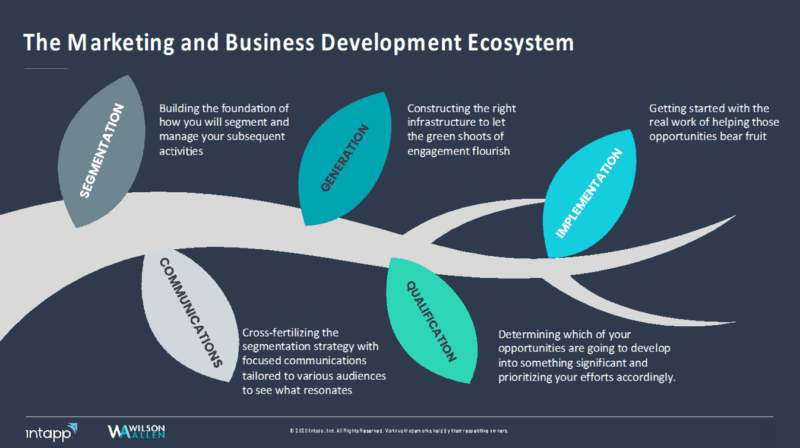Over the course of a four-part webinar series, subject matter experts from Intapp and Wilson Allen have shared industry best practices around legal CRM implementations, and offered practical tips to align law firm people, processes, and data with client needs to drive growth. During the final installment, titled “Bringing Your Technology Stack Together to Improve Business Performance,” Christopher Raymond from Intapp and Michael Warren from Wilson Allen focused on the data component of successful legal CRM implementations and the current shifts many firms are experiencing.

Why the Time Is Right to Pursue Transformation
As global competition increases, professional services firms face a CRM landscape ripe for rejuvenation. Despite taking steps to differentiate and transform themselves, law firms often find change difficult, requiring shifts in behavior that frequently meet with resistance from lawyers and staff. According to Warren and Raymond, the urgent need for change is highlighted by the following points:
- Increased competition — Firms must compete with in-house legal departments, consulting firms, and alternative legal service providers, in addition to the pandemic’s impact.
- Increased expectations — People expect a user and data experience similar to nonbusiness applications, and if it isn’t easy to use or part of the process, people won’t use it.
- Data-related inhibitions — Firms typically struggle to respond to market changes and resist investing in quality data management; the resulting lack of quality data obscures insights.
- Reluctance to engage — Few within the firm, outside of firm marketing departments, use CRM software, which limits opportunities.
How Technology Overcomes Obstacles
As technology finally catches up with expectations around data accessibility and ease of use, firms can more comfortably create, curate, and update content that will drive adoption. Lawyers can obtain real-time information — on demand, from any location, at any time — via their mobile devices. However, to achieve seamless access, firms must devise a plan with a broader view of the marketing and business development ecosystem.
Firm leaders are often tempted to focus marketing and business development technology exclusively on traditional CRM. But CRM proves most successful when it’s integrated across the firm’s entire client engagement lifecycle. Much like a natural ecosystem, each phase has a specific function that serves itself and feeds the next:
- Segmentation — Building the foundation to segment audiences and manage subsequent activities
- Communications — Cross-fertilizing the segmentation strategy using focused discussions tailored to various audiences to see what resonates
- Generation — Constructing the right infrastructure to nourish engagement
- Qualification — Determining which opportunities will develop into significant outcomes, and prioritizing efforts accordingly
- Implementation — Starting the real work to help promising opportunities bear fruit
Ultimately, successful CRM entails following best practices and learning what works and, more importantly, what doesn’t.
How Data Management Can Help
Obtaining the right data is critical to any successful CRM project, and firms that move beyond a traditional data strategy approach achieve the best business outcomes. As such, having good data is key to enabling effective differentiation strategies across all business areas — client satisfaction, revenue generation, profitability, market share, and time to market. Success requires a broader perspective of where that data should originate.
Both Warren and Raymond believe that firms that look only at data generated directly within the CRM system will miss most of the information needed for effective CRM; a single source of truth provides insights, mitigates risk, and drives growth. In contrast, basing business strategies on both internal and external data helps drive execution. By realigning talent and repositioning themselves, firms can increase their chances of winning new clients. As a result, firms can track data points, analyze outcomes, and refine strategy further — none of which can be done successfully if data is siloed across disparate systems.
How Firms Can Overcome Unique Challenges
Warren and Raymond touched on many of the themes discussed in previous webinars, reviewing the data management challenges typically faced by marketing, business development, and leadership team members. They offered suggestions on solving these issues, which enables firms to manage business opportunities, align business processes, and take informed action. The webinar concluded with a summary of useful strategies to help firms combine their technology and data to improve business performance.

Register to watch a replay of the webinar series:
- Part 1 — Practical Tips for Aligning with Client Needs to Drive Growth with Gareth Thomas (Intapp) and Michael Warren (Wilson Allen).
- Part 2 — Key People, Roles, Responsibilities, and Relationships with Darryl Cross (Intapp) and Michael Warren (Wilson Allen).
- Part 3 — Practical Changes that Have a Big Impact on Business Performance with Ryan McCrosson (Intapp) and Anne Reavis (Wilson Allen).
- Part 4 — Bringing Your Technology Stack Together to Improve Business Performance with Christopher Raymond (Intapp) and Michael Warren (Wilson Allen).